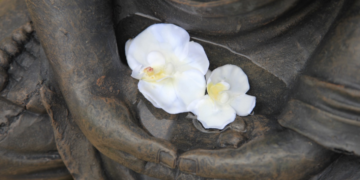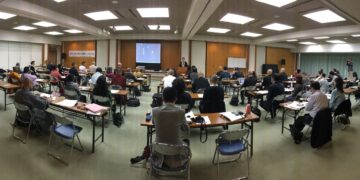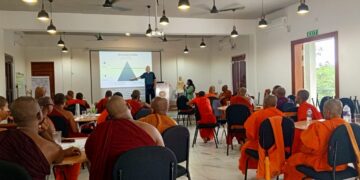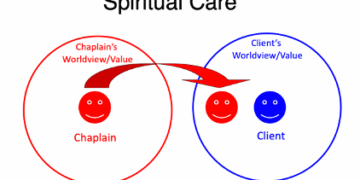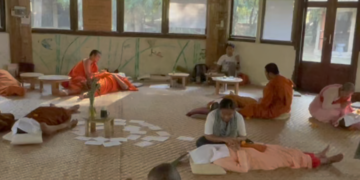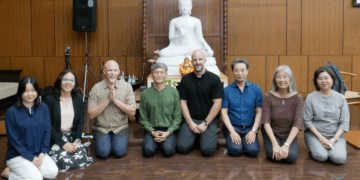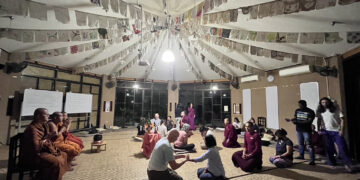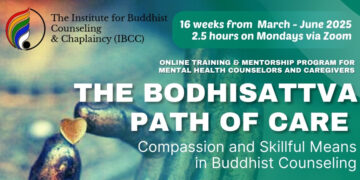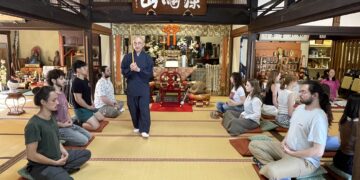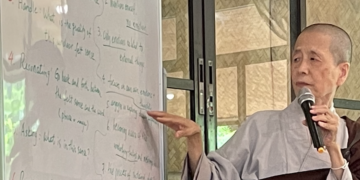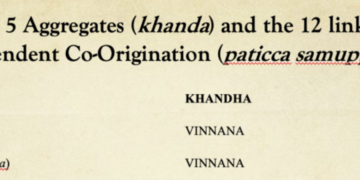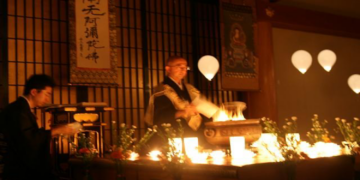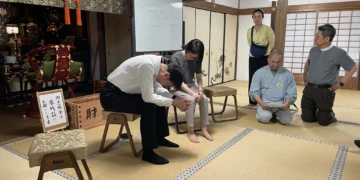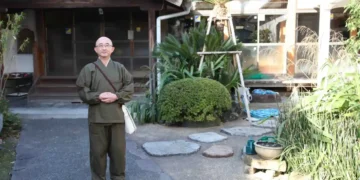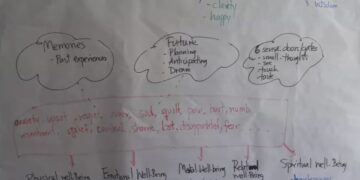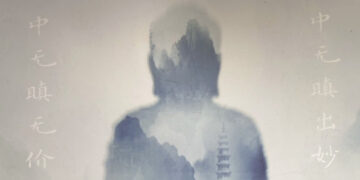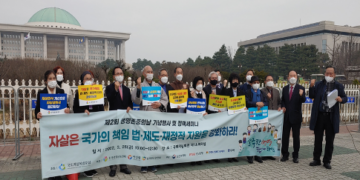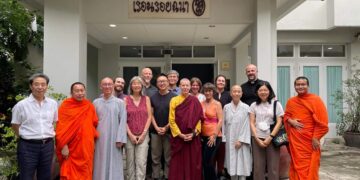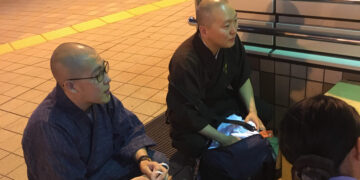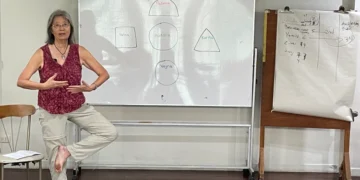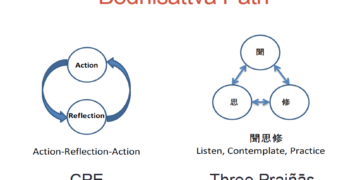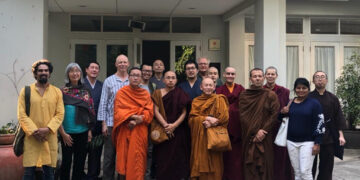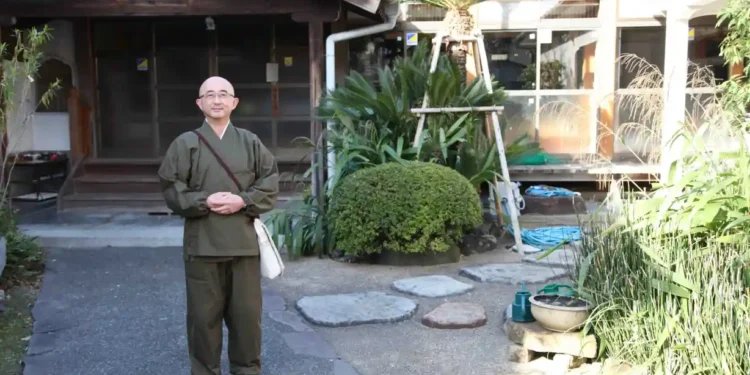Zen Breathing and Its Effect on the Mind: Rev. Soin Fujio
Rev. Soin Fujio is the 56 year-old abbot of Dokuon-ji, a Rinzai Zen temple two hours south of Tokyo in the town Yokosuka, over which a massive American naval base casts its shadow. Rev. Fujio, along with Rev. Shimada, is one of the co-chairs of the Association of Buddhist Priests Confronting Self-death and Suicide. His background suggests the type of Buddhist priest highly suited for working in the secular and public sphere. Although he grew up in Dokuon-ji as the son of the abbot, he developed an interest in high school in globalization and Japanese economic development. His father worked outside of the temple as a schoolteacher, often helping troubled kids, so he encouraged Rev. Fujio to experience and learn about the world outside of the temple before taking ordination. After graduating Meiji University, Rev. Fujio entered the banking world with Kyowa Bank, which after numerous mergers has become Risona Bank. As a young trainee in the Japanese corporate system, he was given the opportunity to spend one year in the United States to learn about the banking system at the now defunct Irving Trust on 1 Wall St. in Manhattan, while also taking summer courses in business at Harvard University. After briefly returning to Japan, he was then stationed by the bank in Singapore for six years and then Bangkok for another six years as the chief of Bangkok regional branch.
It was at this time that he had his first formative encounter with suicide during the financial turmoil that hit Thailand and Southeast Asia in 1997. A friend of his from the same high school was also working in Bangkok with a large and influential Japanese bank. After the Thai government froze all foreign assets, his friend succumbed to the immense pressure from major Japanese investors trying to get their money back. Rev. Fujio recounts that he was also succumbing to depression at this time and feels this was an important experience for him in his present work—to see and understand how people get pushed into a corner, feel desperate, and want to commit suicide.
Shortly after this period, about 15 years ago, Rev, Fujio’s father became ill, so he decided to quit the bank and undergo the arduous Rinzai Zen training to become a priest. After taking up residence at Dokuon-ji again, he naturally became involved in receiving visitors and helping them with various problems. This gradually developed into a more intensive situation in which people outside of his temple community came to visit him for support. His policy has been to never refuse anyone, and he will accept such visitors any time of day or night all year long, though most telephone in advance.
He recounts that sometimes he opens the temple gate in the morning, and someone is waiting there. Such a person, he reports, often looks pale and either cannot talk or talks too much. This kind of depressed person is what he describes as about 50 notches below the normal state of functioning. His first task then is to engage in deep listening without talking and to try to go down into that place of depression through tuning his feeling to their level, meeting the person were they are. This may take a while he says, but when he gets there, there is a feeling of real connection being made. Slowly, the person begins to respond and visible change may occur, such as an improvement in their complexion. It is only at this point that Rev. Fujio begins to speak to them with his own ideas and invite them to ascend with him out of their depths. If they get up to around the normal point of 0, he may invite them to do Zen meditation. At this point, people will start to ask him questions about what they can or should do. He may offer some kind of answer, though he feels there is no real “right answer” and encourages the person to think together on a solution. However, he says that he usually does not go this far during the first few visits with someone and instead just tries to attune to their feeling. In the initial encounter, this process will take about one to three hours, and Rev. Fujio reports that he has even sat with people continuously for eight hours. Typically, one person will visit him up to ten times, sometimes every day in the beginning or once a week.
Rev. Fujio has certainly become busier with such visits as his work with the Association of Buddhist Priests Confronting Self-death and Suicide has attracted more and more public attention. He thinks that the public sense has changed over these past fifteen years and that people are becoming more open to approaching Buddhist priests. As one of the leaders of the Association, Rev. Fujio acts as a group leader at the monthly counseling sessions (wakachi-ai). As in counseling with the depressed and suicidal in his own temple, he notes that after an hour or so of talking, the bereaved calm down, and the priests may shift from just listening to offering some of their own thoughts or responses to their concerns and questions. He reports that people often express feelings of remorse about not preventing the suicide or noticing signs in the person. They also often ask about whether their loved one can go to heaven because they committed suicide or a proper funeral was not performed. The Association has always stressed that Buddhism has no absolute prohibitions on suicide, though it is considered unfortunate, nor absolute judgments on the fate of those who kills themselves. Using a metaphor common to the Japanese Pure Land tradition, Rev. Fujio says that everyone goes to heaven through the compassionate welcoming of the Buddha, no matter how they have died.
At the annual memorial services (tsuito hoyo), Rev. Fujio will burn in the hall letters that the bereaved have written to their loved ones with the sense that the smoke goes to heaven and the messages are being received. Some letters are just a few words, others quite long; some offer reassurance to the dead that their loved ones are OK, some are filled with anger or mixed feelings. Rev. Fujio reports that participants often express great relief to have their messages sent to their loved ones and to be together with others with the same experience and feeling, which leads to a sense of healing. Many also express gratitude to have priests from many sects pray for their loved one during a grand service at a major temple. This is especially significant since the nature of the death led many at the time to hold a very small, private funeral or conduct no funeral at all. Finally, many participants have expressed the feeling that they can carry on in their lives for another year. This is a point of serious concern, since many suicides occur as follow up ones for those unable to handle the grief of the original suicide.

Returning back to his own community, Rev. Fujio also runs a group counseling session (wakachi-ai) for the bereaved once a month at the Yokosuka City public health center as a staff member of the Grief Support Link (zenkoku jishi izoku sogo shien senta 全国自死遺族総合支援センター), an organization hosted by Life Link. Further, along with a psychiatrist and a counselor, he runs a “Gatekeeper” training program, a Japanese-English term and concept created by the government to designate volunteers who help the depressed and suicidal. In this way, he works at the Gatekeeper Training Centre at the city office not as a Buddhist priest but as a volunteer or “gatekeeper”. Still, Rev. Fujio’s identity and status are widely known in the community. He remarks that since it is a small community, the local bureaucrats more easily accept and acknowledge him. This is an unusual situation, especially in Tokyo, in that government bureaucrats are usually the staunchest upholders of the separation of church and state and rarely show interest in the potential social role of Buddhist priests. Rev. Fujio’s case not only illustrates how the Buddhist suicide prevention movement is developing and expanding into the public sphere. It also portends to the growth of the larger socially engaged Buddhist movement in Japan, in which Buddhist priests are slowly but increasingly entering the public sphere, especially in the field of psycho-spiritual care for not only the suicidal but also juvenile delinquents and traumatized survivors of disasters.
See more of Rev. Fujio’s work in these articles:
Pushing Beyond Boundaries: The Korea-Japan Cooperative on Suicide and Self-Death (May 2024)

